2. 东华理工大学核资源与环境国家重点实验室, 南昌 330013;
3. 中国科学院地质与地球物理研究所, 中国科学院地球与行星物理重点实验室, 北京 100029;
4. 中国科学院地球科学研究院, 北京 100029
2. State Key Laboratory of Nuclear Resources and Environment, East China University of Technology, Nanchang 330013, China;
3. Key Laboratory of Earth and Planetary Physics, Institute of Geology and Geophysics, Chinese Academy of Sciences, Beijing 100029, China;
4. Institutions of Earth Science, Chinese Academy of Sciences, Beijing 100029, China
自1945年7月16日美国首次进行核试验以来,至2017年9月3日朝鲜地下核试验为止,全球已知共有约2000次核试验.根据试验环境条件的不同,可主要分为大气层试验、水下试验、高空试验和地下试验四类(Glasstone and Dolan, 1977).目前,全球已知进行过核爆试验的国家中近半数位于中国周围,如朝鲜、印度、巴基斯坦和俄罗斯,中国周边核环境恶劣(图 1).朝鲜自2006年10月9日第一次地下核试验以来,分别于2009年5月25日,2013年2月12日,2016年1月6日,2016年9月9日和2017年9月3日相继进行了6次规模较大的核爆试验(以下简称NKT1, 2, 3, 4, 5和6, 表 1).
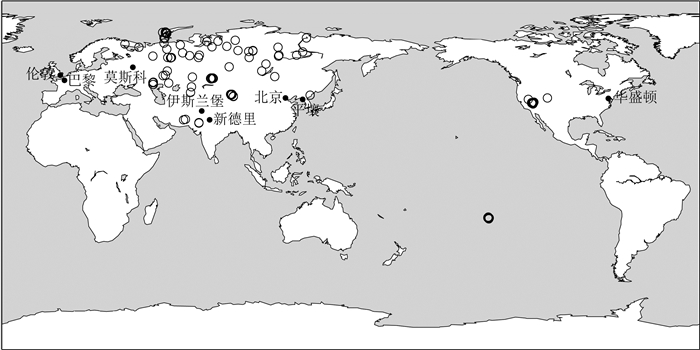
|
图 1 USGS地震目录中全球体波震级4级以上的核试验事件分布 黑色圆点为核试验国家首都,黑色圆圈为1960年以来792余次4级以上核试验位置. Fig. 1 Worldwide nuclear testing (mb≥4.0) recorded by USGS Black dots denote the capitals of which their countries have carried out nuclear testing, and black circles are the locations of nuclear tests since 1960 (mb≥4.0). |
|
|
表 1 朝鲜核试验事件目录 Table 1 Event parameters of the North Korean nuclear tests from USGS |
目前被广泛使用的核试验监测手段主要包括地震、次声、水声和放射性核素等.早期通常进行大气层和水下核试验,其试验当量大、保密性较低,相关监测较为简单直接.进入20世纪60年代之后,随着试验目的的转变、核武器技术的发展以及对环境污染的关注,核试验转入到地下进行,爆炸当量逐渐从高达百万吨减小至几千吨级别.而且通常采用封闭式地下核试验(深层地下核试验),安全性和保密性较高,往往只有少量放射性物质逸出,给全面禁止核试验条约(Comprehensive Nuclear Test Ban Treaty/CTBT)的实施和监督,主要包括小当量核试验的有效监测,带来了新的挑战.
核爆炸可引起地面振动,激发地震波,并被地震仪观测到.基于地震波理论,分析解释波形特征,是识别核试验、测定核爆炸震源参数的有效途径(姚振兴和纪晨, 1997).当前,全球和区域尺度内布设了密集的高质量宽频带数字地震台网(如全球地震台网、中国地震台网、日本FNET台网等),以及国际监测系统(International Monitoring System, IMS)的建立,为核试验监测的地震学研究提供了丰富的数据支撑.同时,随着研究技术的不断创新,地震学方法已成为核试验监测中广泛采用的研究手段(Argo et al., 1995).核试验监测的地震学研究主要包括:(1)测定事件震中位置,即事件定位(Blamey and Gibbs, 1968; Li and Thurber, 1991; Fisk, 2002; Schaff and Richards, 2004; Selby, 2010; Wen and Long, 2010; Murphy et al., 2013; 潘常周等, 2014; Zhao et al., 2017; He et al., 2018); (2)判别事件是核爆炸还是天然地震,即事件识别(Taylor et al., 1989; Walter et al., 1995; Fisk et al., 1996; Hartse et al., 1997; Kim and Richards, 2007; Zhao et al., 2008; Shin et al., 2010; 田有等, 2015; 赵连锋等, 2017); (3)测算核爆的地震学震级以及(4)估计爆炸当量和埋藏深度(Nuttli, 1986a, b; Patton, 1988; Hansen et al., 1990; Vergino and Mensing, 1990; Ringdal et al., 1992; Douglas and Marshall, 1996; Murphy and Barker, 2001; Ni et al., 2010; 范娜等, 2013; Zhao et al., 2012, 2014, 2016;Wei et al., 2018)等内容.事件定位和埋深估计也是重要的事件判别因素,我们在这里将进行单独讨论.
本文根据近几十年来核试验方式的变化和技术的发展,从核爆炸定位、识别、震级测定、当量和埋深估计等方面对核试验监测中相关研究工作进行详细阐述和总结,重点是地震学观测和理论研究方法.
1 核试验地震监测台阵1958年,美国和英国等拥核国家提出了建立地震台阵监测地下核试验的方案,并随即启动了VELA和TABOR PLUTO计划,有效提高了核试验监测能力(Douglas et al., 1999).此后,全球范围内陆续布设了多个大孔径的监测台阵,如LASA(美国)、NORSAR(挪威)等.80年代后期,为满足更高的监测要求,小尺度台阵逐渐在核试验地震监测中占主导.由此发展了诸如NORESS(挪威)、GERESS (德国)等小孔径台阵.1996年,全面禁止核试验条约组织(Comprehensive Nuclear Test Ban Treaty Organization/ CTBTO)建立起规范化的国际监测系统(IMS),以保证全面禁止核试验条约的有效实施.其中,地震监测台阵台站由短周期地震仪和三分量宽频带仪器组成,可以从3个正交方向记录地面运动,通过台网通讯系统完成全球范围内的地震数据及时、有效地传输(叶青和钟卫星, 2016).
我国是最早签署条约的国家之一,积极履行IMS基本台阵建设、地震数据交换等职责.2001年以来,上海佘山、内蒙古海拉尔和甘肃兰州台阵相继建成并投入使用,其中海拉尔和兰州台阵为IMS基本地震台阵.与此同时,国内学者开展了大量研究工作, 在地震台阵技术(台阵设计与评估)研究中取得了丰富成果(例如, 郑重和徐智强, 2000; 朱元清等, 2002; 郝春月等, 2003; 于海英等, 2006).近来,随着西藏那曲和新疆和田台阵的建成使用,我国地震台阵研究得到进一步发展,也为核试验监测提供了有效支撑(郝春月等, 2007).
2 核试验定位的地震学研究在核试验监测中,准确的定位可对检测、识别事件等具有重要意义.例如,天然地震往往发生于活动断裂上,空间位置具有较好的规律性;而核试验一般选择在天然地震活动性低的地区.疑似核爆炸事件发生后,利用其激发的地震波,可以对事件进行高精度定位.地震定位主要包括基于到时定位和基于波形定位两种研究方法.其中,基于到时定位可分为绝对到时定位和相对到时定位.绝对到时定位的精度在一定程度上依赖于地壳模型的准确性,为了降低地壳结构非均匀性所引起的定位误差,提高定位精度,目前已发展出多种相对定位方法,如多事件联合定位法(例如, Douglas, 1967; 王椿镛等, 1993)、主事件法(例如, Spence, 1980; 周仕勇等, 2001)以及双差法等(例如, Waldhauser and Ellsworth, 2000; Klein, 2002; 白玲等, 2003; 杨智娴等, 2003; 吕鹏等, 2011).
Spence(1980)提出了主事件定位法,其基本原理为选择具有准确位置的已知主事件,通过计算周边多个事件相对于主事件的位置,最后获得所有事件的震中位置.设主事件k,其震源参数M(x0k, y0k, z0k)为已知项,与k事件相近的地震事件参数为i,引入台站校正sj,则对于事件i和台站j有
对于事件k:

|
(1) |
对于事件i:

|
(2) |
将(1)式在M点一阶泰勒展开,与(2)式相减得到

|
(3) |
其中δtj=tj-tkj,由上式求得事件i对主事件k的相对位置,从而获得事件i的震源参数.主事件法无需计算主事件、待定事件的到时残差,不需要迭代,结果中相对到时、相对位置的误差较小(田玥和陈晓非, 2002).
双差定位法(Waldhauser and Ellsworth, 2000)的基本思路为:基于射线理论,地震i在台站k的到时表示为

|
(4) |
其中,t0是发震时刻,u是慢度场.设台站k上地震i的走时残差为rik,理论走时为Tik,则有rik=tik-t0*-Tik=δt0+
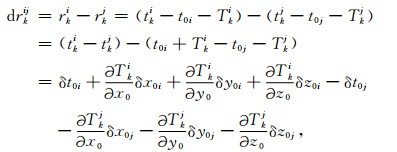
|
(5) |
上式的矩阵形式为

|
(6) |
其中,Δmi=(Δxi, Δyi, Δzi, Δτi).当数据量较少时,可用奇异值分解方法求解方程组得到震源参数;当数据量较大时,采用共轭梯度法.双差定位不要求主事件,其事件对间距离不受限制,适用性、抗干扰性强,使用多种相位的到时差进行定位,效果更为明显(田玥和陈晓非, 2002).
通常,台站分布、走时系统偏差、到时测量误差等会对定位精度产生影响.考虑到核试验的特殊性质和影响,通常会选择在同一个固定的地区反复进行试验,例如美国内华达(Nevada)、前苏联新地岛(Novaya Zemlya)、印度波克兰(Pokhran)以及朝鲜丰溪里(Punggye-ri)核试验场等.同一试验场地的核爆事件主要有以下特点:位置上非常接近,具有相同的地质构造背景,事件性质基本相同,匹配度较高;事件间的走时差主要由它们的起始时间、震中位置以及埋深等因素造成;对于给定的台站,仪器和台基响应是相同的,不同事件的传播路径也几乎相同,从而显著减弱了速度模型的影响.
相对到时定位方法可以减小走时系统偏差影响,提高定位精度,因此被广泛应用于核爆炸事件定位研究中.Blamey和Gibbs(1968)研究了发生在撒哈拉、东哈萨克斯坦以及新地岛等核试验场的核爆炸事件定位;Lilwall和Farthing(1990)采用震中联合定位方法,分别使用单个或多个主事件,测定了哈萨克斯坦核试验场(KTS)数十次核爆炸事件位置;Li和Thurber(1991)选择KTS周边的3个地震台站,使用区域到时数据和P波偏振特征来研究地震和核爆炸定位问题;Thurber等(1993)联合SPOT卫星影像和远震震中定位,获得了1987年至1989年间19次KTS核爆炸事件定位结果,精度达100 m数量级;Selby(2010)使用震中联合定位法,通过7个远震台站对朝鲜核试验进行了相对定位,结果显示NKT2位于NKT1以北400±600 m、以西1800±800 m处;Murphy等(2013)结合波形干涉测量(Snieder and Vrijlandt, 2005)得到NKT1和NKT2的相对定位,发现NKT2位于NKT1以北500 m、以西2300 m.其他还包括法国穆鲁罗瓦(Mururora)试验场(Marshall et al., 1985)、前苏联新地岛试验场(Lilwall and Marshall, 1986)和中国罗布泊(Lop Nor)试验场(Fisk, 2002; Waldhauser et al., 2004)等核爆炸事件定位.
近年来,国内学者在朝鲜地下核试验的事件定位研究中取得了丰富的成果(表 1; 图 2).基于双差定位方法,潘常周等(2014)利用区域和远震台站的垂直分量波形记录,通过计算震相的互相关时差,反演核爆事件对的相对位置,同时由扰动实验以检测不确定度,其定位结果为NKT3位于NKT2以南257 m、以西385 m,NKT1位于NKT2以南503 m、以东2589 m,不确定度约为150 m.得益于卫星影像上清晰观测的NKT1爆炸点附近的地表变化,Wen和Long(2010)使用中国东北、韩国和日本的9个区域地震台站记录,采用卫星图像和USGS给出的NKT1的位置和起始时间,利用Pn波观测的到时差来推断两次事件的相对位置和起始时间,定位结果为NKT2位于NKT1以南723 m、以东2235 m,精度量级约140 m.在此基础上,Zhang和Wen(2013)利用13个区域台站记录,采用相同的方法得到NKT3位于NKT2以南345 m、以西453 m,定位精度约94 m.Zhao等(2014, 2016, 2017)选取信噪比高、波形一致性良好的区域台站Pn波记录,采用互相关方法计算相对走时,将NKT1视为已知事件,用以限制其他核爆事件的起始时间和位置,建立了一个包含多个参数的模型(事件的经纬度,起始时间以及试验场下方的Pn速度结构等),反演观测与理论的相对走时差的极小解,获得各次核爆相对于已知事件的位置信息,最终发现NKT4位于NKT3以北900 m、以西500 m,NKT5位于NKT4以南300 m、以东1000 m,推测NKT5与NKT2、NKT3、NKT4位于同一座山体,其相对定位的不确定度约为90 m.
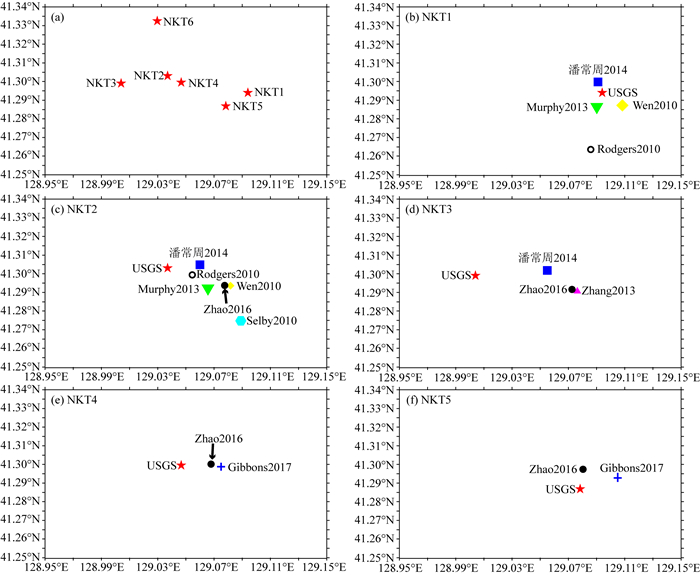
|
图 2 不同研究给出的朝鲜核试验事件定位结果 (a) 6次事件USGS的定位结果; (b) NKT1定位结果; (c) NKT2定位结果; (d) NKT3定位结果; (e) NKT4定位结果; (f) NKT5定位结果. Fig. 2 Location results of the North Korean nuclear tests given by different studies (a) Location results reported by USGS; (b) Location results of the NKT1; (c) Location results of the NKT2; (d) Location results of the NKT3; (e) Location results of the NKT4; (f) Location results of the NKT5. |
核试验事件的识别工作对于全面禁止核试验条约的监督和实施有着重要意义.随着核试验从公开转为秘密的在地下进行,爆炸当量也大幅减小,全面禁止核试验条约的主要目标为检测和识别几千吨TNT或更低当量的核爆炸事件,最小相当于2.5级地震(Fisk et al., 1996).全球每年地震观测记录中,约有成千上万次事件(包括天然地震、采矿爆破等)超过这个震级水平.因此,在核试验监测中,需要分析各种类型事件的地震学特征,对核爆和其他事件进行区分,从而实现事件的判定.
核爆炸和天然地震具有不同的地震波激发机制.主要表现为,天然地震通常是沿着断层面滑动的位错源,所产生的形变以及能量辐射具有一定方向性,主要产生S波,P波能量相对较弱;核爆理论上是各向同性的爆炸源,产生向四周扩散、没有方向性的形变和地震波,主要产生P波,相应地辐射较弱的S波能量.相对于天然地震,核爆通常具有更大的P波振幅和较小的S波振幅(图 3).此外,天然地震的破裂尺度一般远大于核爆,持续时间也更长,震源深度也有较大差异,例如构造地震往往位于5~25 km的深度(Scholtz, 2002; Chen et al., 2015).对于相同震级的核爆炸和天然地震,拐角频率、高频低频的成分比也存在明显区别(谢小碧和赵连锋, 2018).因此,研究者利用上述差异对核爆炸进行识别,主要方法包括谱振幅比(Bennett et al., 1989; Taylor et al., 1989; Baumgardt et al., 1992; Kim et al., 1993; Walter et al., 1995; Fisk et al., 1996; Xie, 2002; Fisk, 2006; Zhao et al., 2008)、面波体波震级判别(Dahlman and Israelson, 1977; Stevens and Day, 1985; Fisk, 2002; Selby et al., 2012)以及震源矩张量(Ford et al., 2009; Alvizuri and Tape, 2018; Liu et al., 2018)等.
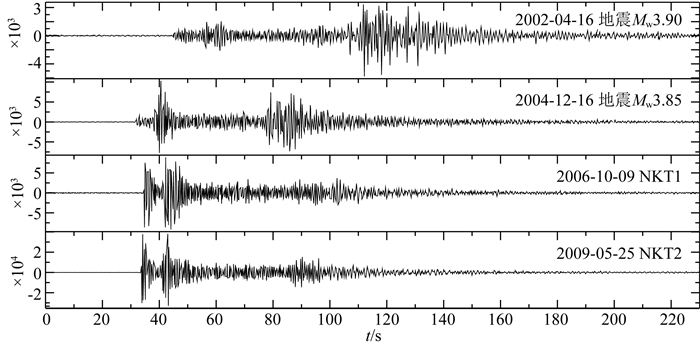
|
图 3 MDJ台站2次天然地震和2次核爆事件0.5~8.0 Hz频带内的垂直分量记录 Fig. 3 Vertical components of 2 earthquakes and 2 nuclear explosion events in the 0.5~8.0Hz frequency band recorded at MDJ station |
使用P波与S波的谱振幅比(P/S)进行地震-核爆判别是一种有效的研究方法,可消除传播中的影响和激发函数效应,突出了不同类型震源之间的差异.分析P波和S波的辐射,量化两者间的差异,可以对核试验和天然地震事件进行识别.
20世纪60年代早期,由于区域范围内观测的复杂性,同时缺乏对地震波传播特征的认知,核试验识别的相关地震学研究集中于远震范围.通常震级较大的地震会产生可探测的面波,早期基于长周期的判别方法(如长周期面波与短周期体波的振幅比),可以对远震距离(>2000 km)上震级较大的事件(mb>4.5)进行有效的识别(Dahlman and Israelson, 1977).然而,当事件震级较小(mb < 4.0)时,往往很难进行长周期测量,即使在几百公里的范围内面波信号也可能会被背景噪声所掩盖.在这种情况下,利用短周期(f>0.5 Hz)测量的地震判别方法开始出现.20世纪80年代后期之前,通常使用短周期窄频带波形数据(例如,Blandford, 1981; Pomeroy et al., 1982),其主要特点是测量方便,可以较为容易地应用一阶距离改正;当比值高于某个阈值时,通常可以进行事件识别.但由于缺乏关于判别机制充分的物理解释,导致大量的不确定性,使得这些基于窄频带时域测量的短周期判别稳健性不足,对诸如构造区域、频率和震相等因素,表现出明显的判别差异.例如,美国西部和欧亚地区的地震与核爆炸事件的研究显示,两种事件的判别结果存在较大重叠,判别效果受传播路径的强烈影响,对区域构造具有明显依赖(Gupta and Burnetti, 1981; Murphy and Bennett, 1982).
80年代后期,高质量数字化观测技术的快速发展,促进了地震信号的频率域研究,利用区域距离(< 1700 km)的地震记录图,进行高频信息判别逐渐成为研究重点.区域地震图包含地壳和上地幔中的多次地震波转换、折射和反射,数据具有相对高频和良好的信噪比,可以通过区域震相信息将判别扩展到较低震级水平,从而实现事件的有效区分.更为重要的是,对同一个事件给定类似的噪声条件,由于区域震相(如Lg波)相对较高的振幅,进行事件判别时会显著降低检测阈值(Pomeroy et al., 1982).在高频区域震相中,Pn和Lg通常是最容易识别的.Pn波是震中距2°~12.5°间的初至震相,并组成在莫霍面多次折射的P波(Cerveny and Ravindra, 1971).Lg波为一种短周期大陆地壳导波,被认为是高阶面波的叠加(Knopoff et al., 1973),或是大陆地壳中多次超临界反射S波(Bouchon, 1982),其辐射比P波更具有各向同性,通常表现为区域地震图中最大的振幅.例如,对于美国东部和非洲地区,在相同距离处的Lg振幅为P波最大振幅的6~10倍大(Chen and Pomeroy, 1980).因此,从宽频带记录中获得不同震相的频谱,根据地震波传播特征进行修正,计算高频范围P/S型的区域震相谱振幅比(Pn/Sn, Pn/Lg, Pg/Lg, Pg/Sn),可以在相关频带条件下进行正确的事件识别(Taylor et al., 1989; Fisk et al., 1996; Hartse et al., 1997; Xie, 2002; Fisk, 2006; Zhao et al., 2008, 2014, 2016, 2017).除试验场中核爆事件外,通常还选取场地附近的区域地震事件,通过垂直分量地震图进行谱振幅比计算,利用垂向地动速度记录(图 4)中P、S波的差异,对区域台网条件下的高频P/S型谱振幅比的识别效果进行对比分析(Zhao et al., 2008).主要技术处理包括,选定不同震相的群速度窗口,反褶积去仪器响应,计算傅里叶位移谱;利用P波初至前的时间窗提取噪声,进行噪声校正;设置信噪比阈值,当低于该数值时自动丢弃,等等.

|
图 4 MDJ台站朝鲜前3次核试验垂直分量速度记录 波形上标出了视群速度值. Fig. 4 Vertical velocities of first three North Korean underground nuclear tests recorded at MDJ station The apparent group velocity value marked in the waveforms. |
虽然区域范围内的核爆与地震事件具有相似的传播路径,但当超过某一较高频率时,核爆的P/S型谱振幅比明显比地震要高.相关学者调查了发生在一些相对稳定的地区(如北欧、中亚、美国东部和加拿大)的核爆和地震事件,发现Pn/Lg或Pg/Lg的高频谱振幅比(>~5 Hz)的判别效果有明显的提升(Dysart and Pulli, 1980; Baumgardt and Young, 1990; Kim et al., 1993). Taylor等(1989)利用4个台站计算了(1~2 Hz)/(6~8 Hz)的Pn、Pg和Lg波的谱振幅比,发现Lg波谱振幅比的判别效果较为理想.Baumgardt等(1992)发现谱振幅比可以很好地区分欧洲中部地质构造活跃的Vogtland地区的地震和化爆事件,推测其判别能力的变化主要来自构造的差异(如稳定与活跃),或是源介质性质的差异(速度,气孔,覆盖层等).Fisk等(1996)使用多变量统计方法在3~8 Hz频带范围内对Pn/Lg,Pn/Sn和Pg/Lg谱振幅比进行测试,发现229个核爆事件中有209个被识别,143次地震中只有2次误报.同时,有关高频谱振幅比判别与距离的相关性研究表明,在低频时谱振幅比对距离有较大的依赖,相反在高频时由于信噪比的作用,比值和距离的相关性不明显.
自2006年朝鲜第一次地下核试验(NKT1)以来,国内外学者针对朝鲜地下核试验的识别工作进行了大量的高频区域震相P/S型谱振幅比研究.Kim和Richards(2007)利用MDJ台站的地震记录,对试验场附近的天然地震以及化学爆炸事件的Pg/Lg谱振幅比进行线性区分,发现大于3.0 Hz时NKT1与地震事件能够较好地区分开,虽然在1~7 Hz范围内与小的化爆事件存在重叠现象,但高于9 Hz时可以进行良好的区分,最终认为在7~15 Hz频带内事件的区分效果最好.其中,旋转的三分量P波与S波谱振幅比(P/S)可表示为(Kim and Richards, 2007)

|
(7) |
下标中的Z, R, T分别表示垂直,径向和切向分量.Koper等(2008)比较了NKT1和17个区域地震事件的MDJ台站记录,计算了1~4 Hz的Pn/Lg和Pg/Lg振幅比,其结果显示核爆事件具有高比值,并随着频率的增加可以更好地从事件总体中区分开.Zhao等(2008)使用中国地震台网的区域地震事件和NKT1记录,并收集了11个已知当量的人工爆炸事件,对NKT1区域震相特征和P/S型谱振幅比进行研究,结果表明在频率高于2 Hz时使用P/S型谱振幅比方法可以有效识别该地区内较低当量的地下核试验事件.田有等(2015)利用临时地震台站记录,通过P/S型谱振幅比法识别NKT1和NKT2事件,并与区域内历史地震记录进行比较,发现在高于3 Hz时能有效区分核爆炸与地震事件.这些结果表明,朝鲜核试验事件的谱振幅比特征与区域内地震事件存在明显的不同,可以进行有效区分.
总体而言,几何扩散、衰减和台基项等因素会对谱振幅比测量造成影响,可以选取某一参考震中距进行校正(Hartse et al., 1997).此外,使用单一台站的观测结果有一定随机性,当数据的信噪比不理想或偏离台网中心时,导致识别存在不确定性(Gupta et al., 1992; Richards and Kim, 2007; Zhao et al., 2008).通过在
在20世纪60年代中期的核试验识别研究中,地震学观测技术和理论方法的重大提高促使远震距离上的MS-mb震级判别开始出现,使远震范围观测的较大震级(mb>4.5)事件得到有效区分(Bolt, 1976; Dahlman and Israelson, 1977; Stevens and Day, 1985; Patton and Randall, 2002; Selby et al., 2012; Ford and Walter, 2015).
Basham(1969)研究了加拿大台网记录的25次内华达核爆(mb范围为4.5~6.3, 对应的MS为3.5~6.3),以及北美西南部地区的28次地震(mb范围为3.8~5.7, 对应的MS为4.0~6.3),发现使用MS-mb判别可以获得核爆与地震间良好的区分效果.McEvilly和Peppin(1972)调查了伯克利地震台站记录的震中距约500 km范围内的51个内华达核爆事件(震级范围为4.0~6.3),以及该地区34个地震、爆炸坍塌和余震事件(震级范围为3.8~6.5),结果显示两组事件集合之间有着良好区分.随后,他们在1974年对相关研究进行了扩展,对加州大学劳伦斯利弗莫尔实验室(UC-LLL)4个台站记录的16个震级相对较小的事件进行判别,获得了不同类型事件间的区分,推测MS-mb判别可以在区域范围内、低震级水平条件下生效.Nuttli(1973)描述了关于地震波衰减与震级的关系,归纳出北美东部的体波震级或面波震级(mb或MS)的经验公式(Evernden, 1967, 1971; Basham, 1971)

|
(8) |
其中A为体波或面波的地面运动振幅,T为周期,B依赖于源区的地震波动周期T的激发,C与地震波衰减系数有关.上式表明震级受
(1) 当20°≤Δ≤130°时,MS=3.30+1.66(logΔ)+ 
(2) 当2°≤Δ≤20°时,MS=2.60+1.66(logΔ)+l
(3) 当0.5°≤Δ≤4°时,从1 s周期的Lg波垂直分量中计算得到

|
(9) |
当4°≤Δ≤30°时,从1s周期的Lg波垂直分量中计算得到

|
(10) |
其中A为峰值振幅.Pomeroy等(1982)研究了发生在美国东部地区的4次地震事件,通过测量的Lg波和Rayleigh波振幅来估计mb(Lg)和MSR,进一步将MS-mb判别扩展到区域范围,利用高频体波能量和低频面波能量的测量,获得了MS和mb的结果.此后,Murphy等(1997)和Selby等(2012)提出了一个利用MS-mb来区分非爆炸事件的判别准则.
3.3 震源矩张量反演震源矩张量也是区分核试验、塌陷和构造地震的重要信息.核试验震源主要为正的各向同性源(Liu et al., 2018; Wang et al., 2018a);而与固体矿产开采有关的塌陷地震主要表现为负的闭合源(Ford et al., 2008; Wang et al., 2018b);大多数构造地震成因为断层错动,其震源机制解中主要为双力偶成分.基于区域地震波形资料,通过反演事件的震源矩张量可以提供关键的地震成因信息.例如,Ford等(2009)根据反演得到的矩张量结果识别了美国中西部及内华达地区的17个爆炸、3个塌陷以及12个构造事件.另外,基于波形数据,学者们利用gCAP以及ISOLA方法反演了NKT6地震序列的震源机制,发现主震主要为爆炸源机制;M4.1余震具有较大的闭合源成分,推测为核试验引起的塌陷事件;ML3.5余震具有较大的双力偶源成分,推测为主震诱发的一次构造事件(Han et al., 2017; Liu et al., 2018).
除此之外,Pomeroy等(1982)系统地分析了其他10余种核爆与地震的区域判别方法(如初动、P2/P1比和频率的三阶矩等),总结了其中较为有效的地下爆炸识别方法,主要包括短周期SH波激发、频谱分布判别以及经验格林函数法等(Pomeroy et al., 1982; Li et al., 1995).
4 核试验的地震学震级测定和当量与埋深估计在获得核试验的事件识别、定位之后,需要对其地震学震级以及当量与埋深进行测定和估计.在地震监测工作中,震级测定是一个至关重要的部分.应用于核试验地震学监测中,震级通常被用于构建探测界限曲线图,区分天然地震和核爆事件以及估计核爆当量等.因此,在本章中我们将震级测定与当量和埋深的估计两方面内容结合在一起进行阐述.
4.1 传统当量和埋深估计方法
早期进行的核试验中爆炸当量较高,研究者通过计算远震P波震级,基于震级与当量之间的经验关系来进行当量的估计(例如, Douglas and Marshall, 1996),如使用均匀全球台网的体波震级平均是较为常见的当量估计方法(Ringdal et al., 1992).远震P波震级mb=



随着核武器的小型化,核爆当量逐渐减少,对于中小地震和低当量核爆事件,远场波形记录一般较弱或信噪比较低,因此使用远场记录来研究核爆较为困难.相比之下,震中距在200~2000 km间的区域震相(如Pn、Pg、Sn和Rg)以及短周期面波Lg等较为容易和清晰地观测到,同时它们对源区性质和地壳、上地幔结构比较敏感,能够呈现有关中小震级和低当量事件的震源特征.在多种区域震相中,Lg波被大陆地壳波导吸收相对较低,稳定性较好,其多路径的采样可以更加适用于体波震级的测定.基于上述优点,区域地震记录成为当量研究中的重要资料(Nuttli, 1973, 1986a, b; Patton, 1988; Hansen et al., 1990; Vergino and Mensing, 1990; Priestley and Patton, 1997; Schlittenhardt, 2001).
Nuttli(1973, 1986a)基于Lg波观测中的第三峰值振幅,结合Lg波震级mb(Lg)与体波震级mb(P),发展了一种区域Lg波震级系统,进而建立与当量之间的关系.并提出了联合区域观测和全球体波震级的区域震级mb(Lg):

|
(11) |
其中A(10)为事件在距离为10 km处产生的Lg波振幅值,C为发生在距离为10 km处mb=5.0地震产生的Lg波振幅,利用合理的衰减模型和几何扩展因子可以将震中距Δ处观测的Lg波振幅外推从而获得A(10).对于Lg波振幅的测量,可以分为第三峰值振幅方法(Nuttli, 1973; Patton, 2001)和均方根振幅方法(Hansen et al., 1990; Ringdal et al., 1992).其中,由第三峰值振幅A(Δ)TP外推到参考距离的振幅为

|
(12) |
式中γ为衰减系数.在此基础上,Patton(1988)利用更大的数据集进一步发展了该方法,并将其应用于内华达试验场.Hansen等(1990)和Ringdal等(1992)对Lg波均方根振幅测量的稳定性及其在当量估计上的可能性进行研究,发现不同地区、不同台站的Lg波均方根观测中振幅的差异很小,而且单个台站测量的精度较高,因此将Lg波均方根振幅转化为震级值(如mb(Lg)),然后校准到给定的震级标度,可以提供良好的核爆当量估计,特别是在稀疏的台网条件下也可以给出有效的当量估计.Patton和Schlittenhardt(2005)进一步研究了Lg波第三峰值振幅和均方根振幅之间震级的对应关系,推广和发展了基于Lg波列第三峰值振幅的方法,并建立了均方根振幅对应的震级:

|
(13) |
当震中距Δ < 1000 km时,均方根振幅外推到参考距离的振幅为

|
(14) |
基于区域震相Pn波,Vergino和Mensing(1990)研究了体波震级mb(Pn)方法.Russell(2006)利用8~25 s周期范围的Rayleigh波,得到相应的时间域面波震级计算方法,且不再局限于近场震级.
通常在利用体波震级或面波震级与当量之间的经验关系进行当量估计时,地震学家会将全球不同地区的经验公式推广到研究区域.然而,试验场地与观测台站之间的路径吸收效应、台站之间高程的不同以及由核爆事件的组成导致相互干渉效应而进行的震级校正等,均会造成震级的不确定性(Douglas et al., 2001).显然,震级与当量的经验公式中参数的选取强烈依赖于该地区的地质条件和介质性质等,例如在体波震级mb与当量W的关系式mb=A+BlgW中,参数A和B为常数,A与源区介质性质和地震波衰减相关,B变化较小通常取0.8,但在不同试验场的A和B具有较大的变化范围(表 2).
|
|
表 2 不同试验场的参数A, B值 Table 2 Values of parameter A and B in different nuclear test sites |
当研究区域内核爆次数较少,缺乏先验数据时,经验公式中参数A和B需要进一步测定,再根据体波震级mb,特别是由区域内Lg波测定的mb来给出合理的当量估计.Nuttli(1986a)根据官方公布的内华达试验场中核爆资料,提出了利用Lg波观测记录来计算核爆当量的方法,得到水浸饱和源环境下的体波震级mb(Lg)与当量W(单位为kt)的经验公式:

|
(15) |
适用于美国部分地区以及法国在撒哈拉沙漠的Reggane核试验场.同时调查了哈萨克斯坦东部核试验场的爆炸当量,推测上述经验关系也可用于其他大陆地区的核爆研究.Ringdal等(1992)和Murphy(1996)分别调查了前苏联Shagan River试验场以及不同地质条件下的和平核爆(PNE)事件,给出了一个发生在稳定地区、完全耦合的核爆事件(如东哈萨克斯坦地区)合理的体波震级-当量公式:

|
(16) |
在此基础上,Bowers等(2001)假定完全耦合事件存在一个最小埋深,并将其作为当量1 kt时核爆的标准深度,给出了一个适用于完全耦合事件、修正的震级-当量关系:

|
(17) |

|
(18) |
该公式同时考虑到不同地区Pn波速度的差异以及低当量事件,适用于新地岛等地区.
Patton(2016)调查了发生在前苏联Balapan、中国罗布泊、法国Hoggar、印度波克兰以及美国Amchitka等5个核试验场的72个已知当量和埋深的硬岩介质下的核爆事件,给出了一个通用的面波震级MS与当量W之间的线性关系:

|
(19) |
其中a=2.50±0.08,b=0.8±0.05.对于完全耦合的标准埋深事件,参数b与MS的标定模型一致,a通常偏移0.45个量级.考虑到内华达试验场中水浸条件下凝灰岩/流纹岩爆炸,b通常大于或等于1.0 (Marshall et al., 1971; Springer and Hannon, 1973; Stevens and Murphy, 2001). Patton(2012)提出了一个改正的内华达试验场水浸条件下硬岩爆炸当量与震级的关系:

|
(20) |
在此基础上,Patton和Pabian(2014)进一步修正并将其应用于朝鲜核试验场的硬岩爆炸环境,得到以下关系:

|
(21) |
该模型适用于在标准埋深(h =120(W)1/3)处进行的高耦合的纯爆炸事件.
根据上述面波震级或体波震级与当量的经验关系,可以对核爆炸的埋深进行估计.不同试验场地的地质条件和传播路径等因素的差异会对结果产生影响和制约.例如,美国内华达试验场和前苏联Shagan River试验场有相近的体波震级mb,而朝鲜丰溪里核试验场中核爆的面波振幅以及震级偏大,导致面波震级获得的当量大于体波震级的结果.因此,将量规地区的震级-当量经验关系应用到一个非量规区域时,会根据试验场地的构造背景进行一些合理的假定,利用已知当量的化学爆炸记录来选择最为合适的震级-当量关系式.这些化爆的当量为使用硝酸铵炸药的重量.与核爆炸相比,相同三硝基甲苯(TNT)当量的化爆在产生地震信号方面的效率高出约2倍(Denny et al., 1996),原因可能是化爆在很浅的深度处引爆,并不满足最小埋深条件.这里,最小埋深条件是指爆炸未造成地表炸裂而出现放射性污染的最小深度(标准埋深),比如1 kt当量通常至少需要120 m的埋深才能保证不出现环境危害.当前利用试验遂道入口与高精度定位确定的试验位置之间的高程差来估计最小埋深是较为常见的研究方法(Zhang and Wen, 2013; Zhao et al., 2017).由于硝酸铵炸药的威力低于TNT炸药,粗略假设1 t硝酸铵炸药相当于0.5 t的TNT当量.在进行转换之后,通过比较不同试验场地的区域地质条件,上地幔Pn波速度以及小化爆事件,如内华达试验场(Nuttli, 1986a)、新地岛(Bowers et al., 2001)和东哈萨克斯坦(Ringdal et al., 1992; Murphy, 1996),从而选择不同的校准震级-当量经验关系.例如,根据丰溪里试验场的地质背景,Zhao等(2014, 2016, 2017)选择Bowers等(2001)中完全耦合的硬岩场地体波震级-当量的关系调查朝鲜核试验的爆炸当量.
此外,Bocharov等(1989)和Jih(1990)给出了适用于Balapan和Murzhik试验场的当量W与埋深h经验公式:h=h0(W)1/4.其中,h0值由场地地质条件以及起爆位置类型(坑道或钻孔)确定.对于美国境内的核试验场,通常认为标准埋深与当量满足h =120(W)1/3或h=120(W)1/4(McLaughlin et al., 1991).利用Lg波均方根振幅测量的体波震级mb(Lg),Israelsson(1994)调查了哈萨克斯坦塞米巴拉金斯克(Semipalatinsk)试验场的核爆事件,获得了标准埋深和当量的关系:h=90(W)1/3.
近来,研究者利用震级-当量-埋深的经验关系,调查了2006至2017年间朝鲜6次地下核试验.例如,Zhao等(2008, 2012, 2014, 2016, 2017)通过中国东北及朝鲜半岛地区多个历史地震事件对给定的地震台网进行量规,利用第三峰值方法和均方根方法计算Lg波体波震级mb(Lg)TP和mb(Lg)rms,根据台网平均的震级和标准差来校正核爆的震级,最后通过震级与当量的经验关系(Bowers et al., 2001)获得了基于最小埋深条件下的朝鲜核试验当量估计.Murphy等(2013)计算了在1~15 Hz内台网平均的Pn波谱振幅比,得到NKT1和NKT2的当量与埋深分别为0.9 kt和200 m及4.6 kt和500 m.Chun等(2011)使用中朝边界附近的流动台网记录的区域Lg波资料得到NKT1和NKT2的当量为1.22 kt和6.51 kt.Rougier等(2011)结合花岗岩介质水动力模拟和近场观测,获得在限定埋深下NKT2的当量为5.7 kt,最小埋深为375 m.Patton(2012)利用mb(P)和矩震级调查了当量与埋深之间的trade-off曲线,给出了针对NKTS的mb偏差以及源介质弹性性质的解释.范娜等(2013)通过区域地震台网的Rayleigh面波震级测量,在8~25 s周期范围内分别计算台基响应并选取改正后的最大振幅震级,有效消除了台基项和辐射花样的影响,获得NKT1和NKT2的Rayleigh波震级和当量估计.
除了震级或振幅与当量的经验关系之外,还可以利用等效震源模型参数得到核爆当量的估计.Lay等(1984)调查了阿拉斯加Amchitka岛的核试验事件,根据核爆等效震源的相对静力学强度得到当量的估计.赵连锋等(2005)根据区域地质和源介质性质的实际情况,采用两个同时起爆的子事件组合的等效震源模型,通过体波反演计算等效震源模型参数,估算了发生在1998年印度波克兰试验场中核爆的当量.
4.2 基于尾波包络方法的当量和埋深估计前文提到的当量估计方法主要是利用震级与当量之间的经验关系获得当量估计,然而在地方性及区域地震范围内,用于当量研究的震相(如Pn, Pg, Sn, Lg等)虽然比较容易观测、识别,但由于自身波形的复杂性,同时容易受到源和路径不均匀性的影响,对应的区域震级可能会存在地域性偏差(如mb(Pg), mb(Pn), mb(Lg), MS, ML, Md).此外,直达波的不确定性导致在实际中需要多台站平均来减少振幅散射,如果站间的平均距离很大(~1500 km),如International Monitoring System台网,由于区域台站数量的限制,影响对直达波测量的平均,可能会给稳定的震级或振幅测量带来困难,进而在震源大小和当量估计上引起误差.相比之下,这些区域震相的尾波对于源区辐射花样、3维路径不均匀性、近台站干扰以及震相阻塞等因素不敏感,波形特征稳定,并且直达波只是整个波形中相对较窄的一部分,只对设定尾波水平有影响.因此,近年来一些研究者基于尾波波形特征,使用区域地震波形的高频波列,建立了用于计算震级和估计当量的尾波法(或区域振幅包络方法)(Mayeda, 1993; Mayeda and Walter, 1996; Mayeda et al., 2003; Murphy et al., 2009; Yoo et al., 2011; Pasyanos et al., 2012; 林鑫和姚振兴, 2016).
Mayeda(1993)使用Aki(1969)中散射模型对4个区域宽频带台站记录的内华达核爆资料进行Lg尾波测量,证明了基于~1Hz区域尾波包络的mb值比基于Pn和Lg波的对应值稳定约4~5倍.Mayeda等(2003)进一步调查死海裂谷地区天然地震,提出了一个经验的尾波校准方法,即利用宽频带地震台站,由区域尾波包络来获取一个稳定的、适应性良好的区域震级.Pasyanos等(2012)发现在尾波和直达波衰减特征之间存在着惊人的相似,证实了Lg波Q值和Lg尾波Q值间有着强烈的一致性(Xie and Mithell, 1990).在此基础上,为了避免在高频波形拟合过程中去匹配那些较为困难的震相细节,Pasyanos等(2012)进一步考虑更广泛的振幅与时间的带宽信息,提出一个拟合地方性及区域地震范围内窄带全波列尾波包络的方法,使用单一地震台站对NKT1和NKT2进行调查,同时获得了当量和埋深的估计结果.
基于先前的研究工作,这里我们简要地阐述尾波法进行核爆当量和埋深估计的基本原理.首先,单个区域震相尾波包络由其震源谱函数S(f),传播特征(几何扩展G(r)和衰减B(f, r)),台基响应P(f),传递函数T(f)及尾波形状函数组成(Mayeda et al., 2003):

|
(22) |
其中H为单位阶跃函数,v(r)为峰值到达速度,γ(f, r)和b(f, r)为尾波形状参数.然后,根据区域震相传播特征拟合震相的尾波振幅衰减,其尾波包络简化为直达波振幅及其尾波(Pasyanos et al., 2012),将地方性及区域地震范围地震全记录的包络归纳为噪声水平与所有区域震相包络之和(图 5a).
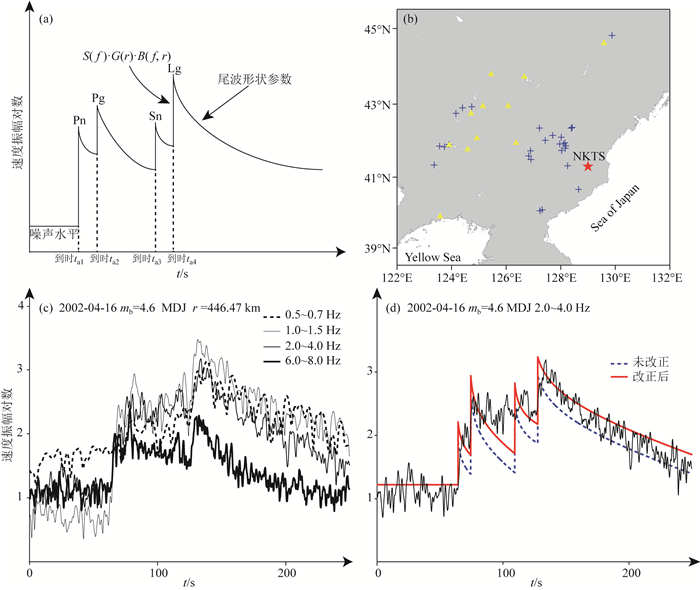
|
图 5 区域地震事件理想包络形状(a),研究区域背景图(b),2002年4月16日区域地震MDJ台站实际包络波形(c),及其理论包络改正(d).(b)中红色五角星为朝鲜地下核试验场,黄色三角为区域台站,蓝色十字为历史地震记录 Fig. 5 (a) Expected envelope shape for regional event; (b) Background of study area, red star shows the North Korean nuclear test site, blue crosses and yellow triangles are historical earthquakes and stations, respectively; (c) Shape of real waveforms envelopes and (d) corrected theory envelopes recorded at MDJ for the regional event on 16 April 2002 |
在实际观测记录中,两个水平分量反褶积去仪器响应,获得速度记录,滤波得到窄频带波形,由窄带包络公式获得窄带包络,再求取两个水平包络的平均值,平滑后得到该频带的尾波包络(图 5c).接着,结合区域范围地震台站(震中距200~500 km)以及区域内历史地震记录(图 5b),对理论包络物理模型中传播、台站、传递函数等参数项进行分析、选取,进而对理论包络做出改正(图 5d).最后,将地震源替换为爆炸源模型,通过网格搜索比较不同当量、不同埋深事件的理论包络与核爆实际波形全波列的包络,计算均方根振幅,得到最佳拟合结果,同时获得对当量和埋深的有效约束(图 6).
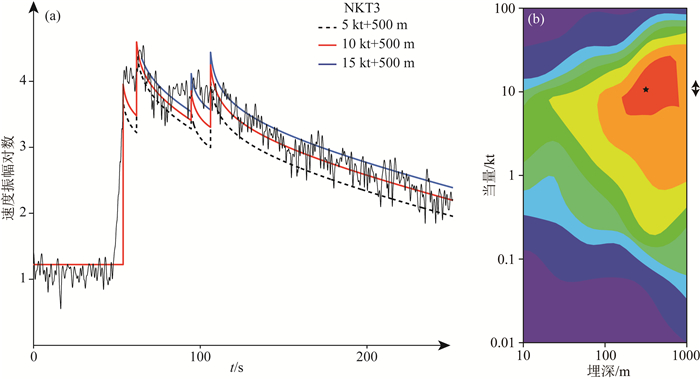
|
图 6 MDJ台站2~4Hz频带内的NKT3拟合结果(a)和网格搜索结果(b) 红色实线为最佳拟合理论包络,黑色五角星为最佳拟合,色标范围表示拟合度由最佳拟合处向四周延伸越来越大. Fig. 6 Fitting (a) and grid searching (b) results of NKT3 at MDJ station (2~4 Hz) Red lines and star are best fitting theory envelopes and best fit, and the color scale from the best fit extend all around means misfit get greater and greater. |
尾波法的主要特点包括以下几个方面:(1)适用性较强,可用于稀疏的地方及区域台网,甚至是单一台站也可以给出较为稳定的当量和埋深的估计;(2)不假定尾波的产生及其衰减机制;(3)使用灵活,可以根据信噪比的优劣来选择震相尾波,不局限于只使用一种类型的尾波.
4.3 地震学与大地测量学联合监测自20世纪90年代初欧空局发射ERS-1遥感卫星以来,利用合成孔径雷达(SAR)和合成孔径雷达干涉(InSAR)影像获取地表形变信息已成为一种新兴的测地学方法.SAR基本原理可概括为利用雷达发射微波脉冲,接收地表反射信号得到目标的表面起伏或构造影像.InSAR技术是通过对同一地区观测的两幅包含幅值和相位的影像数据进行相干处理,获取地表高程信息.SAR和InSAR测量可以提供高精度空间分辨率的观测数据,不仅对震源机制、断层模型及参数等有良好的约束,还能够给出涵盖震前、同震和震后的动态形变信息,近年来常用于地震学相关研究(例如, Massonnet et al., 1993; Fielding et al., 2005; Shen et al., 2009; Feng et al., 2010; Xu et al., 2010; 季灵运等, 2017; 单新建等, 2017).
Wei(2017)使用InSAR测量最大静态地面位移,利用ALOS-2和Sentinal-1A卫星数据对NKT4进行了高精度的定位.Myers等(2018)结合地下爆炸源的弹性有限元模拟和基于InSAR的地表位移观测(包括地形影响),通过区域和远震体波的到时和差分到时,获得了6次朝鲜核试验的事件定位.Wang等(2018a)利用卫星获取核爆前后的雷达影像,得到NKT6造成的地表三维形变场;基于弹性位错模型,反演震源位置和深度,计算理论地表形变场;同时考虑地形影响,比较理论形变场和SAR影像形变场来确定反演结果;根据能量-深度-当量之间的经验关系,最终得到NKT6的埋深约450 m、当量为120~304 kt,远远超过1945年美国投放到日本广岛的“小男孩”原子弹(约15 kt)的威力.
传统的地震学方法可以精细地刻画破裂的动态过程,SAR和InSAR卫星影像能够呈现地表形变信息,结合两种观测方法得到核爆事件较为完整的过程,较好地弥补了地震波在精确的绝对定位和深度研究中的部分问题,可以对全球范围的地下核试验进行有效监测.
5 讨论相关学者在爆炸定位、识别、震级测定、当量和埋深估计等方面取得了丰富的研究成果.然而,目前在相关研究中或多或少存在着一些问题.
首先,当前的相对定位结果通常是基于一个局部的1D模型来计算的,而源区附近的3D结构会引起额外的散射,使波形复杂化并导致互相关误差,进而影响相对位置的结果,如由于NKT1的位置更偏东,其激发的Pn波形与其他朝鲜核试验事件的波形记录存在一定的差异,这些差异可能在定位时引起额外的误差(Zhao et al., 2016).在稀疏台站情况下,台站对事件的包围效果存在不足,可能会给定位结果带来较大的误差(潘常周等, 2014).此外,全球P波和区域Pn波的不同走时测量之间存在差异,Gibbons等(2017)尝试通过一种优化方法来消除这些差异,提高相对定位的准确性.
其次,对于区域范围内中小震级地震和低当量事件,MS-mb识别的适用性及有效性依赖于区域震级系统的准确测定(Patton, 2001; Bonner et al., 2003),激发的复杂性也会导致震级存在差异,可能使该识别不再是一个理想的判别准则(Stevens and Day, 1985; Patton and Randall, 2002; Ford and Walter, 2015).例如,Bonner等(2008)和Zhao等(2017)使用MS-mb识别方法调查了朝鲜地下核试验,发现核爆和地震存在高度重合,识别效果较差.此外,不同研究所使用的面波震级测定方法大体相同,但可能在数据的使用中没有或没能有效地去除台基效应,导致结果出现较大的差异(Bonner et al., 2008; Hong et al., 2008; Murphy et al., 2010; Shin et al., 2010; Chun et al., 2011).
另外,尾波法对当量与埋深的约束依赖于爆炸源模型,不同源模型给出的约束范围存在较大差异,如MM71模型(Mueller and Murphy, 1971),DJ91模型(Denny and Johnson, 1991)、MDAC2模型(Walter and Taylor, 2001)以及Fisk猜想模型(Fisk, 2006).同时,传递函数主要由区域内历史地震记录经验推导,其合理性仍需进一步解释.我们测试了振幅包络对深度和当量变化的敏感性,并将NKT1-NKT5的最佳拟合范围近似矩形区域处理,得到变化图(图 7).发现包络对当量的变化比较敏感,相反对深度的敏感性较低,导致同一当量条件下的深度约束效果并不是十分出色.就目前而言,可以引入相对定位对当量和埋深进行更精确的约束(Pasyanos and Myers, 2018).
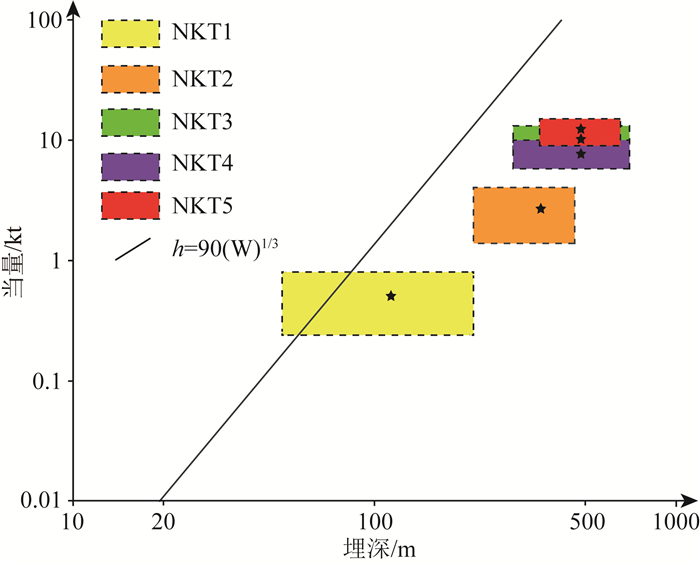
|
图 7 朝鲜前5次地下核试验最佳拟合范围变化 图中五角星为最佳拟合,斜线为埋深与当量关系(Israelsson, 1994). Fig. 7 Best fitting range changes of first five nuclear tests Stars are best fits, and thin line shows the relationship between yield and depth (Israelsson, 1994). |
通常在研究核试验震源参数时,大部分工作是基于中长周期地震波形资料,对核试验震源深度约束较差(Ford et al., 2009).为了提高波形资料对震源深度的约束,可使用较高频率的地震波(Alvizuri and Tape, 2016).例如,Stevens和O′Brien(2018)发现在0.5~1 Hz时地表反射震相振幅对震源埋深比较敏感,浅地表爆炸源具有一定的非均匀性(Liu et al., 2018; Alvizuri and Tape, 2018).但是,大部分研究没有考虑三维速度结构以及地形起伏的影响,未来可以进一步研究复杂结构模型以及地形条件对核试验震源参数反演的影响.
最后,高质量的数字地震仪可以实时(几秒到几十秒间)探测到核爆所产生的震动,但在利用SAR或InSAR卫星时,通常在事后几天才能获取形变影像,可能会出现地表形变信息不能准确描述该核爆事件的问题.例如,NKT6引起的地表形变可能是由爆炸以及随后的坍塌事件共同综合影响(Myers et al., 2018),该坍塌事件被认为是与核爆后约8分半后发生的地震事件有关,由爆炸和坍塌源产生的混合信号也给核试验监测工作带来困难.
6 结论由于核爆炸和天然地震的机理不同(如地震波激发机制),地震学家通过核爆产生的地震波来进行核试验监测研究.早期,美国和前苏联的若干试验场(如内华达,新地岛等)都曾公布过一些较大当量事件的相关信息,利用试验场附近的天然地震、化学爆炸等事件,可以获得适用于这些场地准确的震级-当量-埋深关系.近年来,在全面禁止核试验条约的背景下,全球试验数量少、爆炸当量低,且当量与埋深信息未知,导致大多数试验场地未能进行良好的标定,也给核试验监测的地震学研究带来了新的挑战(谢小碧和赵连锋, 2018).
本文综合分析了核试验监测的地震学观测、理论和方法.地震学方法具有多尺度观测、近实时捕获、全球性监控等优势,已成为广泛使用的、高可靠性的监测手段.利用全球尺度地震台站记录的核爆激发的地震波,分析波形数据,获取震相到时、频谱以及振幅等信息,可以进行核试验监测的地震学研究,如定位、识别、震级、当量和埋深等.另一方面,核试验监测的地震学研究很好地推进了全球地震台网、台阵的布设和数据的共享,促进了包括地球内部精细结构、全球大陆地区地壳速度结构和衰减结构模型、震源机制以及地震定位等相关研究,可为地震学的发展和未来核试验的监测提供重要支撑.
致谢 感谢美国地震学研究机构联合会(IRIS)提供的朝鲜地下核试验的数据资料,感谢陈浩朋博士和张宝龙博士提供的宝贵建议和帮助.文中图件采用GMT软件绘制,感谢两位审稿专家提出的宝贵修改建议.
Aki K. 1969. Analysis of the seismic coda of local earthquakes as scattered waves. Journal of Geophysical Research, 74(2): 615-631. DOI:10.1029/JB074i002p00615 |
Alvizuri C, Tape C. 2016. Full moment tensors for small events (Mw < 3) at Uturuncu volcano, Bolivia. Geophysical Journal International, 206(3): 1761-1783. DOI:10.1093/gji/ggw247 |
Alvizuri C, Tape C. 2018. Full moment tensor analysis of nuclear explosions in North Korea. Seismological Research Letters, 89(6): 2139-2151. DOI:10.1785/0220180158 |
Argo P, Clark R A, Douglas A, et al. 1995. The detection and recognition of underground nuclear explosions. Surveys in Geophysics, 16(4): 495-532. DOI:10.1007/BF00665683 |
Bache T C. 1982. Estimating the yield of underground nuclear explosions. Bulletin of the Seismological Society of America, 72(6B): S131-S168. |
Bai L, Zhang T Z, Zhang H Z. 2003. Multiplet relative location and wave correlation correction and their application. Acta Seismological Sinica (in Chinese), 25(6): 591-600. |
Basham P W. 1969. Canadian magnitudes of earthquakes and nuclear explosions in south-western North America. Geophysical Journal International, 17(1): 1-13. DOI:10.1111/j.1365-246X.1969.tb06375.x |
Basham P W. 1971. A new magnitude formula for short period continental Rayleigh waves. Geophysical Journal of the Royal Astronomical Society, 23(2): 255-260. DOI:10.1111/j.1365-246X.1971.tb01817.x |
Båth M. 1969. Handbook on Earthquake Magnitude Determinations. Michigan: Geophysics Laboratory, Willow Run Laboratories, University of Michigan.
|
Baumgardt D, Carney J, Maxson M, et al. 1992. Evaluation of Regional Seismic Discriminants using the Intelligent Seismic Event Identification System. Springfield, VA: ENSCO.
|
Baumgardt D R, Young G B. 1990. Regional seismic waveform discriminants and case-based event identification using regional arrays. Bulletin of the Seismological Society of America, 80(6B): 1874-1892. |
Bennett T J, Barker B W, McLaughlin K L, et al. 1989. Regional discrimination of quarry blasts, earthquakes and underground nuclear explosions. La Jolla CA: S-CUBED.
|
Blamey C, Gibbs P G. 1968. The epicentres and origin times of some large explosions. Geophysical Journal of the Royal Astronomical Society, 16(1): 1-7. DOI:10.1111/j.1365-246X.1968.tb07130.x |
Blandford R R. 1981. Seismic discrimination problems at regional distances.//Husebye E S, Mykkeltveit S eds. Identification of Seismic Sources-Earthquake or Underground Explosion. Dordrecht: Springer, 695-740.
|
Bocharov V S, Zelentsov S A, Mikhailov V N. 1989. Characteristics of 96 underground nuclear explosions at the Semipalatinsk proving ground. Soviet Atomic Energy, 67(3): 691-695. DOI:10.1007/BF01123212 |
Bolt B A. 1976. Nuclear Explosions and Earthquakes:The parted veil. San Francisco, California: W. H. Freeman and Company: 309.
|
Bonner J, Herrmann R B, Harkrider D, et al. 2008. The surface wave magnitude for the 9 October 2006 North Korean nuclear explosion. Bulletin of the Seismological Society of America, 98(5): 2498-2506. DOI:10.1785/0120080929 |
Bonner J L, Harkrider D G, Herrin E T, et al. 2003. Evaluation of short-period, near-regional MS scales for the Nevada Test Site. Bulletin of the Seismological Society of America, 93(4): 1773-1791. DOI:10.1785/0120020240 |
Bouchon M. 1982. The complete synthesis of seismic crustal phases at regional distances. Journal of Geophysical Research:Solid Earth, 87(B3): 1735-1741. DOI:10.1029/JB087iB03p01735 |
Bowers D, Marshall P D, Douglas A. 2001. The level of deterrence provided by data from the SPITS seismometer array to possible violations of the Comprehensive Test Ban in the Novaya Zemlya region. Geophysical Journal International, 146(2): 425-438. DOI:10.1046/j.1365-246x.2001.01462.x |
Bowman J R, Kennett B L N. 1991. Propagation of Lg waves in the North Australian craton:influence of crustal velocity gradients. Bulletin of the Seismological Society of America, 81(2): 592-610. |
Cerveny V, Ravindra R. 1971. Theory of Seismic Head Waves. Toronto, Ont., Canada: University of Toronto Press.
|
Chen T C, Pomeroy P W. 1980. Regional Seismic Wave Propagation. Stone Ridge, New York: Rondout Associates, Inc..
|
Chen W W, Ni S D, Kanamori H, et al. 2015. CAPjoint, a computer software package for joint inversion of moderate earthquake source parameters with local and teleseismic waveforms. Seismological Research Letters, 86(2A): 432-441. DOI:10.1785/0220140167 |
Chun K Y, Wu Y, Henderson G A. 2011. Magnitude estimation and source discrimination:A close look at the 2006 and 2009 North Korean underground nuclear explosions. Bulletin of the Seismological Society of America, 101(3): 1315-1329. DOI:10.1785/0120100202 |
Dahlman O, Israelson H. 1977. Monitoring Underground Nuclear Explosions. Amsterdam:Elsevier Scientific Publishing Company: 440. |
Denny M, Goldstein P, Mayeda K, et al. 1996. Seismic results from DOE's Non-Proliferation Experiment: A comparison of chemical and nuclear explosions.//Husebye E S, Dainty A M eds. Monitoring a Comprehensive Test Ban Treaty. Dordrecht: Springer, 355-364.
|
Denny M D, Johnson L R. 1991. The explosion seismic source function: Models and scaling laws reviewed.//Taylor S R, Patton H J, Richards P G eds. Explosion Source Phenomenology. Washington, D. C.: Geophysical Monograph Series, 65: 1-24.
|
Douglas A. 1967. Joint epicentre determination. Nature, 215(5096): 47-48. DOI:10.1038/215047a0 |
Douglas A, Marshall P D. 1996. Seismic source size and yield for nuclear explosions.//Husebye E S, Dainty A M eds. Monitoring a Comprehensive Test Ban Treaty. Netherlands: Springer, 309-353.
|
Douglas A, Bowers D, Marshall P D, et al. 1999. Putting nuclear-test monitoring to the test. Nature, 398(6727): 474. DOI:10.1038/19000 |
Douglas A, Marshall P D, Bowers D, et al. 2001. The yields of the Indian nuclear tests of 1998 and their relevance to Test Ban verification. Current Science, 81: 72-74. |
Dysart P S, Pulli J J. 1980. Regional seismic event classification at the NORESS array:seismological measurements and the use of trained neural networks. Bulletin of the Seismological Society of America, 80(6B): 1910-1933. |
Evernden J F. 1967. Magnitude determination at regional and near-regional distances in the United States. Bulletin of the Seismological Society of America, 57(4): 591-639. |
Evernden J F. 1971. Variation of Rayleigh-wave amplitude with distance. Bulletin of the Seismological Society of America, 61(2): 231-240. |
Fan N, Zhao L F, Xie X B, et al. 2013. Measurement of Rayleigh-wave magnitudes for North Korean nuclear tests. Chinese Journal of Geophysics (in Chinese), 56(3): 906-915. |
Feng G C, Hetland E A, Ding X L, et al. 2010. Coseismic fault slip of the 2008 MW7.9 Wenchuan earthquake estimated from InSAR and GPS measurements. Geophysical Research Letters, 37(1): L01302. DOI:10.1029/2009GL041213 |
Fielding E J, Talebian M, Rosen P A, et al. 2005. Surface ruptures and building damage of the 2003 Bam, Iran, earthquake mapped by satellite synthetic aperture radar interferometric correlation. Journal of Geophysical Research:Solid Earth, 110(B3): B03302. DOI:10.1029/2004JB003299 |
Fisk M D, Gray H L, McCartor G D. 1996. Regional event discrimination without transporting thresholds. Bulletin of the Seismological Society of America, 86(5): 1545-1558. |
Fisk M D. 2002. Accurate locations of nuclear explosions at the Lop Nor test site using alignment of seismograms and IKONOS satellite imagery. Bulletin of the Seismological Society of America, 92(8): 2911-2925. DOI:10.1785/0120010268 |
Fisk M D. 2006. Source spectral modeling of regional P/S discriminants at nuclear test sites in China and the former Soviet Union. Bulletin of the Seismological Society of America, 96(6): 2348-2367. DOI:10.1785/0120060023 |
Ford S R, Dreger D S, Walter W R. 2008. Source characterization of the 6 August 2007 Crandall Canyon Mine seismic event in central Utah. Seismological Research Letters, 79(5): 637-644. DOI:10.1785/gssrl.79.5.637 |
Ford S R, Dreger D S, Walter W R. 2009. Source analysis of the memorial day explosion, Kimchaek, North Korea. Geophysical Research Letters, 36(21): L21304. DOI:10.1029/2009GL040003 |
Ford S R, Walter W R. 2015. International monitoring system correlation detection at the North Korean nuclear test site at Punggye-ri with insights from the source physics experiment. Seismological Research Letters, 86(4): 1160-1170. DOI:10.1785/0220150029 |
Gibbons S J, Pabian F, Näsholm S P, et al. 2017. Accurate relative location estimates for the North Korean nuclear tests using empirical slowness corrections. Geophysical Journal International, 208(1): 101-117. DOI:10.1093/gji/ggw379 |
Glasstone S, Dolan P J. 1977. The Effects of Nuclear Weapons. Washington D.C.: Available from US Government Printing Office.
|
Gupta I N, Burnetti J A. 1981. An investigation of discriminants for events in Western USSR based on regional phases recorded at station Kabul. Bulletin of the Seismological Society of America, 71(1): 263-274. |
Gupta I N, Chan W W, Wagner R A. 1992. A comparison of regional phases from underground nuclear explosions at East Kazakh and Nevada Test Sites. Bulletin of the Seismological Society of America, 82(1): 352-382. |
Han L B, Wu Z L, Jiang C S, et al. 2017. Properties of three seismic events in September 2017 in the northern Korean Peninsula from moment tensor inversion. Science Bulletin, 62(23): 1569-1571. DOI:10.1016/j.scib.2017.11.007 |
Hansen R A, Ringdal F, Richards P G. 1990. The stability of RMS Lg measurements and their potential for accurate estimation of the yields of Soviet underground nuclear explosions. Bulletin of the Seismological Society of America, 80(6B): 2106-2126. |
Hao C Y, Zheng Z, Zhou W G. 2003. The calculation and analysis of correlation for Lanzhou seismic array site survey and the estimation of array response. Acta Seismological Sinica (in Chinese), 25(6): 608-614. |
Hao C Y, Zheng Z, Mou L Y. 2007. Array seismology, seismic array and CTBT/IMS. Earthquake Research in China (in Chinese), 23(3): 233-244. |
Hartse H E, Taylor S R, Phillips W S, et al. 1997. A preliminary study of regional seismic discrimination in central Asia with emphasis on western China. Bulletin of the Seismological Society of America, 87(3): 551-568. |
He X, Zhao L F, Xie X B, et al. 2018. High-precision relocation and event discrimination for the 3 September 2017 underground nuclear explosion and subsequent seismic events at the North Korean test site. Seismological Research Letters, 89(6): 2042-2048. |
Hong T K, Baag C E, Choi H, et al. 2008. Regional seismic observations of the 9 October 2006 underground nuclear explosion in North Korea and the influence of crustal structure on regional phases. Journal of Geophysical Research:Solid Earth, 113(B3): B03305. DOI:10.1029/2007JB004950 |
Israelsson H. 1994. Analysis of historical seismograms-root mean square Lg magnitudes, yields and depths of explosions at the Semipalatinsk Test Range. Geophysical Journal International, 117(3): 591-609. DOI:10.1111/j.1365-246X.1994.tb02456.x |
Ji L Y, Liu C J, Xu J, et al. 2017. InSAR observation and inversion of the seismogenic fault for the 2017 Jiuzhaigou MS7.0 earthquake in China. Chinese Journal of Geophysics (in Chinese), 60(10): 4069-4082. DOI:10.6038/cjg20171032 |
Jih R S. 1990. Geotech's magnitude-yield study during 1989-1990.//Lewkowics J, McPhetres J eds. Proceedings of the Twelfth Annual DARPAI/GL Seismic Research Symposium, Hanscom AFB, MA: Geophysics Laboratory.
|
Kim W Y, Simpson D W, Richards P G. 1993. Discrimination of earthquakes and explosions in the eastern United States using regional high-frequency data. Geophysical Research Letters, 20(14): 1507-1510. DOI:10.1029/93GL01267 |
Kim W Y, Richards P G. 2007. North Korean nuclear test:Seismic discrimination low yield. Eos, Transactions American Geophysical Union, 88(14): 158-161. |
Klein F W. 2002. User's guide to HYPOINVERSE-2000, a Fortran program to solve for earthquake locations and magnitudes. US Geological Survey Open-File Report.
|
Knopoff L, Schwab F, Kauselt E. 1973. Interpretation of Lg. Geophysical Journal International, 33(4): 389-404. DOI:10.1111/j.1365-246X.1973.tb02375.x |
Koper K D, Herrmann R B, Benz H M. 2008. Overview of open seismic data from the North Korean event of 9 October 2006. Seismological Research Letters, 79(2): 178-185. DOI:10.1785/gssrl.79.2.178 |
Lay T, Burdick L J, Helmberger D V. 1984. Estimating the yields of the Amchitka tests by waveform intercorrelation. Geophysical Journal of the Royal Astronomical Society, 78(1): 181-207. DOI:10.1111/j.1365-246X.1984.tb06478.x |
Li Y P, Thurber C H. 1991. Hypocenter constraint with regional seismic data:A theoretical analysis for the Natural Resources Defense Council Network in Kazakhstan, USSR. Journal of Geophysical Research:Solid Earth, 96(B6): 10159-10176. DOI:10.1029/91JB00482 |
Li Y P, Toksöz M N, Rodi W. 1995. Source time functions of nuclear explosions and earthquakes in central Asia determined using empirical Green's functions. Journal of Geophysical Research:Solid Earth, 100(B1): 659-674. DOI:10.1029/94JB02465 |
Lilwall R C, Marshall P D. 1986. Body wave magnitudes and locations of Soviet underground explosions at the Novaya Zemlya Test Site. London: HMSO.
|
Lilwall R C, Farthing J. 1990. Joint epicentre determination of Soviet underground nuclear explosions 1973-89 at the Semipalatinsk test site. AWE Report No. O. London: HMSO.
|
Lin X, Yao Z X. 2016. Yield and burial depth of the North Korean underground nuclear tests constrained by amplitude envelopes of regional seismic waveforms. Chinese Journal of Geophysics (in Chinese), 59(6): 2066-2079. DOI:10.6038/cjg20160613 |
Liu J Q, Li L, Zahradník J, et al. 2018. North Korea's 2017 Test and its Nontectonic Aftershock. Geophysical Research Letters, 45(7): 3017-3025. DOI:10.1002/2018GL077095 |
Lv P, Ding Z F, Zhu L P. 2011. Application of double-difference relocation technique to aftershocks of 2008 Wenchuan earthquake using waveform cross-correlation. Acta Seismological Sinica (in Chinese), 33(4): 407-419. |
Marshall, P D, Douglas A, Hudson J A. 1971. Surface waves from underground explosions. Nature, 234(5323): 8-9. DOI:10.1038/234008a0 |
Marshall P D, Lilwall R C, Warburton P J. 1985. Body wave magnitudes and locations of French underground explosions at the Mururoa test site. London: HMSO.
|
Massonnet D, Rossi M, Carmona C, et al. 1993. The displacement field of the Landers earthquake mapped by radar interferometry. Nature, 364(6433): 138-142. DOI:10.1038/364138a0 |
Mayeda K. 1993. mb(Lg coda):A stable single station estimator of magnitude. Bulletin of the Seismological Society of America, 83(3): 851-861. |
Mayeda K, Walter W R. 1996. Moment, energy, stress drop, and source spectra of western United States earthquakes from regional coda envelopes. Journal of Geophysical Research:Solid Earth, 101(B5): 11195-11208. DOI:10.1029/96JB00112 |
Mayeda K, Hofstetter A, O'Boyle J L, et al. 2003. Stable and transportable regional magnitudes based on coda-derived momentrate spectra. Bulletin of the Seismological Society of America, 93(1): 224-239. DOI:10.1785/0120020020 |
McEvilly T V, Peppin W A. 1972. Source characteristics of earthquakes, explosions and afterevents. Geophysical Journal of the Royal Astronomical Society, 31(1-3): 67-82. DOI:10.1111/j.1365-246X.1972.tb02359.x |
McLaughlin K L, Stevens J L, Barker T G, et al. 1991. Investigations of non-linear explosions effects.//Lewkowics J, McPhetres J eds. Proceedings of the 13th Annual DARPA/GL Seismic Research Symposium. Hanscom AFB, MA: Geophysics Laboratory, 8-10.
|
Mueller R A, Murphy J R. 1971. Seismic characteristics of underground nuclear detonations:Part Ⅰ. Seismic spectrum scaling. Bulletin of the Seismological Society of America, 61(6): 1675-1692. |
Murphy J R. 1981. P wave coupling of underground explosions in various geologic media.//Husebye E S, Mykkeltveit S eds. Identification of Seismic Sources-Earthquake or Underground Explosion. Dordrecht: Springer, 201-205.
|
Murphy J R, Bennett T J. 1982. A discrimination analysis of short-period regional seismic data recorded at Tonto Forest Observatory. Bulletin of the Seismological Society of America, 72(4): 1351-1366. |
Murphy J R. 1996. Types of seismic events and their source descriptions.//Husebye E S, Dainty A M eds. Monitoring a Comprehensive Test Ban Treaty. Dordrecht: Springer, 225-245.
|
Murphy J R, Barker B W, Marshall M E. 1997. Event screening at the IDC using the Ms/mb discriminant. Maxwell Technologies final report, 23. |
Murphy J R, Barker B W. 2001. Application of network-averaged teleseismic P-wave spectra to seismic yield estimation of underground nuclear explosions.//Ekström G, Denny M, Murphy J R eds. Monitoring the Comprehensive Nuclear-Test-Ban Treaty: Source Processes and Explosion Yield Estimation. Basel: Birkhäuser, 2123-2171.
|
Murphy J R, Stevens J L, Kohl B C, et al. 2013. Advanced seismic analyses of the source characteristics of the 2006 and 2009 North Korean nuclear tests. Bulletin of the Seismological Society of America, 103(3): 1640-1661. DOI:10.1785/0120120194 |
Murphy K R, Mayeda K, Walter W R. 2009. Lg-coda methods applied to Nevada Test Site events:Spectral peaking and yield estimation. Bulletin of the Seismological Society of America, 99(1): 441-448. DOI:10.1785/0120080046 |
Myers S C, Ford S R, Mellors R J, et al. 2018. Absolute locations of the North Korean nuclear tests based on differential seismic arrival times and InSAR. Seismological Research Letters, 89(6): 2049-2058. DOI:10.1785/0220180123 |
Ni S D, Helmberger D, Pitarka A. 2010. Rapid source estimation from global calibrated paths. Seismological Research Letters, 81(3): 498-504. DOI:10.1785/gssrl.81.3.498 |
Nuttli O W. 1973. Seismic wave attenuation and magnitude relations for eastern North America. Journal of Geophysical Research, 78(5): 876-885. DOI:10.1029/JB078i005p00876 |
Nuttli O W. 1986a. Yield estimates of Nevada Test Site explosions obtained from seismic Lg waves. Journal of Geophysical Research:Solid Earth, 91(B2): 2137-2151. DOI:10.1029/JB091iB02p02137 |
Nuttli O W. 1986b. Lg magnitudes of selected East Kazakhstan underground explosions. Bulletin of the Seismological Society of America, 76(5): 1241-1251. |
Pan C Z, Jin P, Xu X, et al. 2014. Relative locations among the 2006, 2009 and 2013 North Korean underground nuclear tests. Acta Seismological Sinica (in Chinese), 36(5): 910-918. |
Pasyanos M E, Walter W R, Mayeda K M. 2012. Exploiting regional amplitude envelopes:a case study for earthquakes and explosions in the Korean Peninsula. Bulletin of the Seismological Society of America, 102(5): 1938-1948. DOI:10.1785/0120120012 |
Pasyanos M E, Myers S C. 2018. The coupled location/depth/yield problem for North Korea's Declared Nuclear Tests. Seismological Research Letters, 89(6): 2059-2067. DOI:10.1785/0220180109 |
Patton H J. 1988. Application of Nuttli's method to estimate yield of Nevada Test Site explosions recorded on Lawrence Livermore National Laboratory's digital seismic system. Bulletin of the Seismological Society of America, 78(5): 1759-1772. |
Patton H J. 2001. Regional magnitude scaling, transportability, and MS:mb discrimination at small magnitude. Pure and Applied Geophysics, 158(11): 1951-2015. DOI:10.1007/PL00001138 |
Patton H J, Randall G E. 2002. On the causes of biased estimates of seismic moment for earthquakes in central Asia. Journal of Geophysical Research:Solid Earth, 107(B11): ESE8-1-ESE 8-16. DOI:10.1029/2001jb000351 |
Patton H J, Schlittenhardt J. 2005. A transportable mb(Lg) scale for central Europe and implications for low-magnitude Ms-mb discrimination. Geophysical Journal International, 163(1): 126-140. DOI:10.1111/j.1365-246X.2005.02663.x |
Patton H J. 2012. Modeling Ms-yield scaling of Nevada Test Site nuclear explosions for constraints on volumetric moment due to source-medium damage. Bulletin of the Seismological Society of America, 102(4): 1373-1387. DOI:10.1785/0120110302 |
Patton H J, Pabian F V. 2014. Comment on "Advanced Seismic Analyses of the Source Characteristics of the 2006 and 2009 North Korean Nuclear Tests" by JR Murphy, JL Stevens, BC Kohl, and TJ Bennett. Bulletin of the Seismological Society of America, 104(4): 2104-2110. DOI:10.1785/0120130262 |
Patton H J. 2016. A physical basis for Ms-yield scaling in hard rock and implications for late-time damage of the source medium. Geophysical Journal International, 206(1): 191-204. DOI:10.1093/gji/ggw140 |
Pomeroy P W, Best W J, McEvilly T V. 1982. Test ban treaty verification with regional data-A review. Bulletin of the Seismological Society of America, 72(6B): S89-S129. |
Priestley K F, Patton H J. 1997. Calibration of mb(Pn), mb(Lg) scales and transportability of the M0:mb discriminant to new tectonic regions. Bulletin of the Seismological Society of America, 87(5): 1083-1099. |
Richards P G, Kim W Y. 2007. Seismic signature. Nature Physics, 3(1): 4-6. DOI:10.1038/nphys495 |
Ringdal F, Marshall P D, Alewine R W. 1992. Seismic yield determination of Soviet underground nuclear explosions at the Shagan River test site. Geophysical Journal International, 109(1): 65-77. DOI:10.1111/j.1365-246X.1992.tb00079.x |
Rougier E, Patton H J, Knight E E, et al. 2011. Constraints on burial depth and yield of the 25 May 2009 North Korean test from hydrodynamic simulations in a granite medium. Geophysical Research Letters, 38(16). DOI:10.1029/2011GL048269 |
Russell D R. 2006. Development of a time-domain, variable-period surface-wave magnitude measurement procedure for application at regional and teleseismic distances, part Ⅰ:Theory. Bulletin of the Seismological Society of America, 96(2): 665-677. DOI:10.1785/0120050055 |
Schaff D P, Richards P G. 2004. Repeating seismic events in China. Science, 303(5661): 1176-1178. DOI:10.1126/science.1093422 |
Schlittenhardt J. 2001. Teleseismic Lg of Semipalatinsk and Novaya Zemlya Nuclear Explosions Recorded by the GRF (Gräfenberg) Array:Comparison with Regional Lg (BRV) and their Potential for Accurate Yield Estimation. Pure and Applied Geophysics, 158(11): 2253-2274. DOI:10.1007/PL00001148 |
Scholz C H. 2002. The Mechanics of Earthquakes and Faulting 2nd ed. Cambridge: Cambridge University Press.
|
Selby N D. 2010. Relative locations of the October 2006 and May 2009 DPRK announced nuclear tests using international monitoring system seismometer arrays. Bulletin of the Seismological Society of America, 100(4): 1779-1784. DOI:10.1785/0120100006 |
Selby N D, Marshall P D, Bowers D. 2012. mb:Ms event screening revisited. Bulletin of the Seismological Society of America, 102(1): 88-97. DOI:10.1785/0120100349 |
Shan X J, Qu C Y, Gong W Y, et al. 2017. Coseismic deformation field of the Jiuzhaigou Ms7.0 earthquake from Sentinel-1A InSAR data and fault slip inversion. Chinese Journal of Geophysics (in Chinese), 60(12): 4527-4536. DOI:10.6038/cjg20171201 |
Shen Z K, Sun J B, Zhang P Z, et al. 2009. Slip maxima at fault junctions and rupturing of barriers during the 2008 Wenchuan earthquake. Nature geoscience, 2(10): 718-724. DOI:10.1038/ngeo636 |
Shin J S, Sheen D H, Kim G. 2010. Regional observations of the second North Korean nuclear test on 2009 May 25. Geophysical Journal International, 180(1): 243-250. DOI:10.1111/j.1365-246X.2009.04422.x |
Snieder R, Vrijlandt M. 2005. Constraining the source separation with coda wave interferometry:Theory and application to earthquake doublets in the Hayward fault, California. Journal of Geophysical Research:Solid Earth, 110(B4): B04301. DOI:10.1029/2004JB003317 |
Spence W. 1980. Relative epicenter determination using P-wave arrival-time differences. Bulletin of the Seismological Society of America, 70(1): 171-183. |
Springer D L, Hannon W J. 1973. Amplitude-yield scaling for underground nuclear explosions. Bulletin of the Seismological Society of America, 63(2): 477-500. |
Stevens J L, Day S M. 1985. The physical basis of mb:Ms and variable frequency magnitude methods for earthquake/explosion discrimination. Journal of Geophysical Research:Solid Earth, 90(B4): 3009-3020. DOI:10.1029/JB090iB04p03009 |
Stevens J L, Murphy J R. 2001. Yield estimation from surface-wave amplitudes. Pure and Applied Geophysics, 158(11): 2227-2251. DOI:10.1007/PL00001147 |
Stevens J L, O'Brien M. 2018. 3D nonlinear calculation of the 2017 North Korean nuclear test. Seismological Research Letters, 89(6): 2068-2077. DOI:10.1785/0220180099 |
Taylor S R, Denny M D, Vergino E S, et al. 1989. Regional discrimination between NTS explosions and western US earthquakes. Bulletin of the Seismological Society of America, 79(4): 1142-1176. |
Thurber C H, Quin H R, Richards P G. 1993. Accurate locations of nuclear explosions in Balapan, Kazakhstan, 1987 to 1989. Geophysical Research Letters, 20(5): 399-402. DOI:10.1029/93GL00173 |
Tian Y, Chen X F. 2002. Review of seismic location study. Progress in Geophysics (in Chinese), 17(1): 147-155. |
Tian Y, Liu Y L, Liu C, et al. 2015. Comparative study on seismological characteristics of 2009 and 2013 nuclear explosions in North Korea. Chinese Journal of Geophysics (in Chinese), 58(3): 809-820. DOI:10.6038/cjg20150311 |
Vergino E S, Mensing R W. 1990. Yield estimation using regional mb(Pn). Bulletin of the Seismological Society of America, 80(3): 656-674. |
Waldhauser F, Ellsworth W L. 2000. A double-difference earthquake location algorithm:Method and application to the northern Hayward fault, California. Bulletin of the Seismological Society of America, 90(6): 1353-1368. DOI:10.1785/0120000006 |
Waldhauser F, Schaff D, Richards P G, et al. 2004. Lop Nor revisited:Underground nuclear explosion locations, 1976-1996, from double-difference analysis of regional and teleseismic data. Bulletin of the Seismological Society of America, 94(5): 1879-1889. DOI:10.1785/012003184 |
Walter W R, Mayeda K M, Patton H J. 1995. Phase and spectral ratio discrimination between NTS earthquakes and explosions. Part Ⅰ:Empirical observations. Bulletin of the Seismological Society of America, 85(4): 1050-1067. |
Walter W R, Taylor S R. 2001. A revised magnitude and distance amplitude correction (MDAC2) procedure for regional seismic discriminants:Theory and testing at NTS. Lawrence. Livermore, CA: Lawrence Livermore National Laboratory (LLNL).
|
Wang T, Shi Q B, Nikkhoo M, et al. 2018a. The rise, collapse, and compaction of Mt. Mantap from the 3 September 2017 North Korean nuclear test. Science, 361(6398): 166-170. |
Wang X T, Wang S F, Li Z W, et al. 2018b. Source Characterization of Some Collapse Earthquakes due to Mining Activities in Shandong and Beijing, North China. Seismological Research Letters, 90(1): 183-193. |
Wen L X, Long H. 2010. High-precision location of North Korea's 2009 nuclear test. Seismological Research Letters, 81(1): 26-29. DOI:10.1785/gssrl.81.1.26 |
Wei M. 2017. Location and source characteristics of the 2016 January 6 North Korean nuclear test constrained by InSAR. Geophysical Journal International, 209(2): 762-769. DOI:10.1093/gji/ggx053 |
Wei Z, Zhao L F, Xie X B, et al. 2018. Seismic characteristics of the 15 February 2013 bolide explosion in Chelyabinsk, Russia. Earth and Planetary Physics, 2(5): 420-429. |
Xie J, Mitchell B J. 1990. A back-projection method for imaging large-scale lateral variations of Lg coda Q with application to continental Africa. Geophysical Journal International, 100(2): 161-181. DOI:10.1111/j.1365-246X.1990.tb02477.x |
Xie J K. 2002. Source scaling of Pn and Lg spectra and their ratios from explosions in central Asia:Implications for the identification of small seismic events at regional distances. Journal of Geophysical Research:Solid Earth, 107(B7): ESE 1-1-ESE 1-13. DOI:10.1029/2001JB000509 |
Xie X B, Zhao L F. 2018. The seismic characterization of North Korea underground nuclear tests. Chinese Journal of Geophysics (in Chinese), 61(3): 889-904. DOI:10.6038/cjg2018L0677 |
Xu C J, Wang J J, Li Z H, et al. 2010. Applying the Coulomb failure function with an optimally oriented plane to the 2008 MW7. 9 Wenchuan earthquake triggering. Tectonophysics, 491(1-4): 119-126. |
Yang Z X, Chen Y T, Zheng Y J, et al. 2003. Accurate relocation of earthquakes in central-western China using the double-difference earthquake location algorithm. Science in China Series D:Earth Sciences, 46(S2): 181-188. |
Yao Z X, Ji C. 1997. The inverse problem of finite fault study in time domain. Acta Geophysica Sinica (in Chinese), 40(5): 691-701. |
Ye Q, Zhong W X. 2016. Technical system of IMS network. Recent Developments in World Seismology (in Chinese), 11: 28-34. |
Yoo S H, Rhie J, Choi H, et al. 2011. Coda-derived source parameters of earthquakes and their scaling relationships in the Korean Peninsula. Bulletin of the Seismological Society of America, 101(5): 2388-2398. DOI:10.1785/0120100318 |
Yu H Y, Zhu Y Q, Kan D L, et al. 2006. Research on result and the calibration for the location of seismic array in Shanghai. Earthquake Research in China (in Chinese), 22(2): 190-196. |
Zhang M, Wen L X. 2013. High-precision location and yield of North Korea's 2013 nuclear test. Geophysical Research Letters, 40(12): 2941-2946. DOI:10.1002/grl.50607 |
Zhao L F, Wang W M, Li J, et al. 2005. Yield estimation of the 11 May 1998 Indian nuclear test using relative static source strength. Chinese Journal of Geophysics (in Chinese), 48(5): 1092-1097. |
Zhao L F, Xie X B, Wang W M, et al. 2008. Regional seismic characteristics of the 9 October 2006 North Korean nuclear test. Bulletin of the Seismological Society of America, 98(6): 2571-2589. DOI:10.1785/0120080128 |
Zhao L F, Xie X B, Wang W M, et al. 2012. Yield estimation of the 25 May 2009 North Korean nuclear explosion. Bulletin of the Seismological Society of America, 102(2): 467-478. DOI:10.1785/0120110163 |
Zhao L F, Xie X B, Wang W M, et al. 2014. The 12 February 2013 North Korean Underground Nuclear Test. Seismological Research Letters, 85(1): 130-134. DOI:10.1785/0220130103 |
Zhao L F, Xie X B, Wang W M, et al. 2016. Seismological investigation of the 2016 January 6 North Korean underground nuclear test. Geophysical Journal International, 206(3): 1487-1491. DOI:10.1093/gji/ggw239 |
Zhao L F, Xie X B, Wang W M, et al. 2017. The 9 September 2016 North Korean Underground Nuclear Test Short Note. Bulletin of the Seismological Society of America, 107(6): 3044-3051. DOI:10.1785/0120160355 |
Zhao L F, Xie X B, He X, et al. 2017. Seismological discrimination and yield estimation of the 3 September 2017 Democratic People's Republic of Korea (DPRK) underground nuclear test. Chinese Science Bulletin (in Chinese), 62(35): 4163-4168. DOI:10.1360/N972017-00979 |
Zheng Z, Xu Z Q. 2000. Array site survey for two new IMS primary stations in China and their power spectrum estimations of ground motion noise. Seismological and Geomagnetic Observation and Research (in Chinese), 21(6): 11-18. |
Zhou S Y, Xu Z H, Chen X F. 2001. Analysis on the source characteristics of the 1997 Jiashi swarm, western China. Chinese Journal of Geophysics (in Chinese), 44(5): 654-662. |
Zhu Y Q, Tong Y X, Song J G. 2002. The design of Shanghai seismic array. Seismological and Geomagnetic Observation and Research (in Chinese), 23(2): 13-23. |
白玲, 张天中, 张宏智. 2003. 多重相对定位法和波形相关校正及其应用. 地震学报, 25(6): 591-600. DOI:10.3321/j.issn:0253-3782.2003.06.004 |
范娜, 赵连锋, 谢小碧, 等. 2013. 朝鲜核爆的Rayleigh波震级测量. 地球物理学报, 56(3): 906-915. DOI:10.6038/cjg20130319 |
郝春月, 郑重, 周公威. 2003. 兰州台阵勘址测点相关值曲线的计算分析与初选台阵评估. 地震学报, 25(06): 608-614. DOI:10.3321/j.issn:0253-3782.2003.06.006 |
郝春月, 郑重, 牟磊育. 2007. 台阵地震学, 地震台阵与禁核试条约监测系统. 中国地震, 23(3): 233-244. DOI:10.3969/j.issn.1001-4683.2007.03.003 |
季灵运, 刘传金, 徐晶, 等. 2017. 九寨沟MS7.0地震的InSAR观测及发震构造分析. 地球物理学报, 60(10): 4069-4082. DOI:10.6038/cjg20171032 |
林鑫, 姚振兴. 2016. 利用区域地震波形振幅包络约束朝鲜地下核试验的埋深和当量. 地球物理学报, 59(6): 2066-2079. DOI:10.6038/cjg20160613 |
吕鹏, 丁志峰, 朱露培. 2011. 结合波形互相关的双差定位方法在2008年汶川地震余震序列中的应用. 地震学报, 33(4): 407-419. DOI:10.3969/j.issn.0253-3782.2011.04.001 |
潘常周, 靳平, 徐雄, 等. 2014. 对朝鲜2006年, 2009年和2013年3次地下核试验的相对定位. 地震学报, 36(5): 910-918. |
单新建, 屈春燕, 龚文瑜, 等. 2017. 2017年8月8日四川九寨沟7.0级地震InSAR同震形变场及断层滑动分布反演. 地球物理学报, 60(12): 4527-4536. DOI:10.6038/cjg20171201 |
田有, 柳云龙, 刘财, 等. 2015. 朝鲜2009年和2013年两次核爆的地震学特征对比研究. 地球物理学报, 58(3): 809-820. DOI:10.6038/cjg20150311 |
田玥, 陈晓非. 2002. 地震定位研究综述. 地球物理学进展, 17(1): 147-155. DOI:10.3969/j.issn.1004-2903.2002.01.022 |
王椿镛, 王溪莉, 颜其中. 1993. 昆明地震台网多事件定位问题的初步研究. 地震学报, 15(2): 136-145. |
谢小碧, 赵连锋. 2018. 朝鲜地下核试验的地震学观测. 地球物理学报, 61(3): 889-904. DOI:10.6038/cjg2018L0677 |
杨智娴, 陈运泰, 郑月军, 等. 2003. 双差地震定位法在我国中西部地区地震精确定位中的应用. 中国科学(D辑), 33(S1): 129-134. |
姚振兴, 纪晨. 1997. 时间域内有限地震断层的反演问题. 地球物理学报, 40(5): 691-701. DOI:10.3321/j.issn:0001-5733.1997.05.010 |
叶青, 钟卫星. 2016. 国际监测系统(IMS)地震台站技术系统. 国际地震动态, 11: 28-34. |
于海英, 朱元清, 阚道玲, 等. 2006. 上海地震台阵标定结果研究. 中国地震, 22(2): 190-196. DOI:10.3969/j.issn.1001-4683.2006.02.009 |
赵连锋, 王卫民, 李娟, 等. 2005. 利用相对静力学强度测定1998年5月11日印度核爆的当量. 地球物理学报, 48(5): 1092-1097. DOI:10.3321/j.issn:0001-5733.2005.05.016 |
赵连锋, 谢小碧, 何熹, 等. 2017. 2017年9月3日朝鲜地下核试验的地震学鉴别和当量估计. 科学通报, 62(35): 4163-4168. DOI:10.1360/N972017-00979 |
郑重, 徐智强. 2000. 海拉尔兰州核查地震台阵的勘址和地动噪声功率谱的计算. 地震地磁观测与研究, 21(6): 11-18. DOI:10.3969/j.issn.1003-3246.2000.06.002 |
周仕勇, 许忠淮, 陈晓非. 2001. 伽师强震群震源特征及震源机制力学成因分析. 地球物理学报, 44(5): 654-662. DOI:10.3321/j.issn:0001-5733.2001.05.009 |
朱元清, 佟玉霞, 宋俊高. 2002. 上海地震台阵的设计方法. 地震地磁观测与研究, 23(2): 13-23. DOI:10.3969/j.issn.1003-3246.2002.02.003 |
 2019, Vol. 62
2019, Vol. 62

